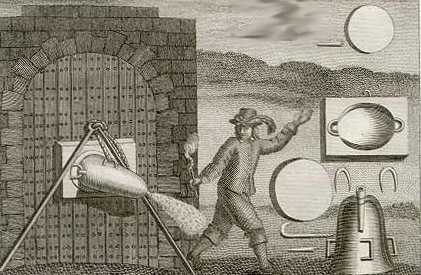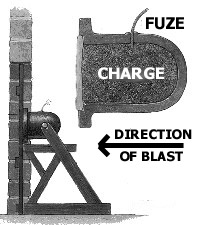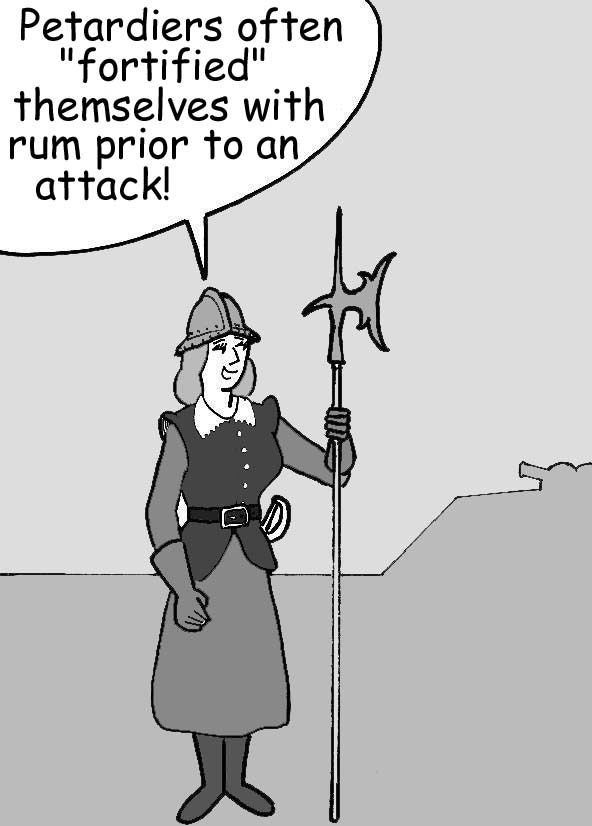
PETARDIERS
 ______During the era of the 30 Years War artillerymen were a rarity. The use of artillery was more of an art than a science. It was during this time that the petardier made his appearance.
______During the era of the 30 Years War artillerymen were a rarity. The use of artillery was more of an art than a science. It was during this time that the petardier made his appearance.
______Petardiers were used during sieges of castles or fortified cities. Their weapon was a rather primitive and exceedingly dangerous explosive device: the petard. The petard consisted of a brass or iron bell-shaped device filled with gunpowder fixed to a wooden base. The device was attached to a wall or gate using hooks and rings, the fuze lit and, if successful, the resulting explosive force would be concentrated at the target point and would blow a hole in the obstruction, allowing assault troops to enter.
 ______Imagine if you will a besieged garrison armed with muskets and other weapons who see a small team of men (usually there was one Chief Petardier and four rank-and-file Petardiers in an assault force) running towards the gate holding what looks like a bell. The defending garrison is NOT going to think "Avon is calling." The reception waiting for the Petardier would be very warm indeed.
______Imagine if you will a besieged garrison armed with muskets and other weapons who see a small team of men (usually there was one Chief Petardier and four rank-and-file Petardiers in an assault force) running towards the gate holding what looks like a bell. The defending garrison is NOT going to think "Avon is calling." The reception waiting for the Petardier would be very warm indeed.
______Even if the petardier managed to get to the target, attach the device and set the fuze he was still in danger of being killed by the device itself. Fuzes were of indifferent quality and might burn down much faster than planned. Or stray gunpowder might get lit by the fuze and instantly set off the main charge. Or the petard might function precisely as designed and STILL kill the petardier because he forgot to leave the scene from a side angle.
______When under fire the usual response of the human survival instinct is to get away by the most direct means possible. The straight line is rarely the safest route of departure while under fire, however, and this was doubly true after setting a petard. The backblast of the device would go straight away from the fortification, and if the petardier went straight back as well he would be "hoist by his own petard," as the saying goes.
 ______In addition to the anti-fortification petard there was another weapon for use against troops in line. This appears to have been almost a sort of grenade or mine. It wasn't very popular to use.
______In addition to the anti-fortification petard there was another weapon for use against troops in line. This appears to have been almost a sort of grenade or mine. It wasn't very popular to use.
______The first petardiers made their appearance about 1589 and the last around 1728, when reliable and professional artillery organizations were taking their place in European military establishments. Even primitive artillery pieces provided a surer and safer means to breech walls than the petard. Theoretically the last of the petardiers were dropped from the rolls and not simply killed in action.
______During the wars of the 20th century the word "petard" came back into limited use to describe some types of grenades and anti-tank weapons but petardiers themselves have not made a big comeback, at least not in name. Sappers and combat engineers using explosive devices more sophisticated than the petard to breech fortifications where heavy weapons are unavailable or impractical.
WHAT WERE SOVIET DOG MINES?







 ______During the era of the 30 Years War artillerymen were a rarity. The use of artillery was more of an art than a science. It was during this time that the petardier made his appearance.
______During the era of the 30 Years War artillerymen were a rarity. The use of artillery was more of an art than a science. It was during this time that the petardier made his appearance. ______Imagine if you will a besieged garrison armed with muskets and other weapons who see a small team of men (usually there was one Chief Petardier and four rank-and-file Petardiers in an assault force) running towards the gate holding what looks like a bell. The defending garrison is NOT going to think "Avon is calling." The reception waiting for the Petardier would be very warm indeed.
______Imagine if you will a besieged garrison armed with muskets and other weapons who see a small team of men (usually there was one Chief Petardier and four rank-and-file Petardiers in an assault force) running towards the gate holding what looks like a bell. The defending garrison is NOT going to think "Avon is calling." The reception waiting for the Petardier would be very warm indeed.  ______In addition to the anti-fortification petard there was another weapon for use against troops in line. This appears to have been almost a sort of grenade or mine. It wasn't very popular to use.
______In addition to the anti-fortification petard there was another weapon for use against troops in line. This appears to have been almost a sort of grenade or mine. It wasn't very popular to use.